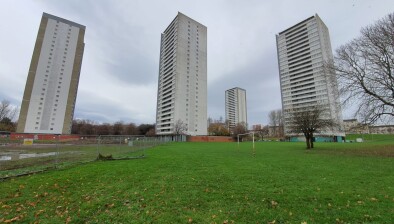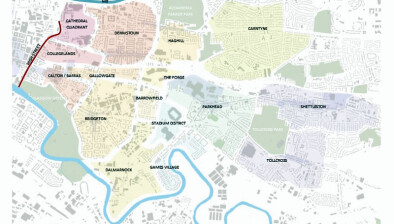Blog: How digital engineering excellence spurred construction in Glasgow’s financial district
Rapid population growth and an increasingly dense urban environment means that engineering projects in city centres are becoming more intricate and complex. Whether digging new tunnels in London’s vast Tube network, navigating mazes of underground sewers, cabling and ventilation, or renovating buildings with minimal disruption to the surrounding roads, there’s a lot of pressure on engineers to deliver projects more quickly, safely and efficiently, while grappling with many margins in the process. One wrong calculation could have a serious impact.
Advancements in engineering technology is playing a key role in accelerating construction projects, such as Mabey’s recent redevelopment of Atlantic Square in Glasgow’s financial district.
Developing a unique solution for a complex engineering challenge
Working with BAM Construction, we are using a unique propping system alongside BIM services to facilitate this complex new build development. However, an added complication is that part of this new development incorporates the existing façade of a historic Grade I listed building, which needs supporting (and keeping safe) while the construction of the new 284,000 square feet office space takes place. It’s a tricky situation, but what is known as a façade-retention system provides transitional building support on the structure’s outside façade as construction is finalised and permanent supports are put in place over the next year.
Alongside retaining this historic structure, BAM Properties required a solution which would avoid full road closures in a commuter-heavy area. Using previous propping experience, we delivered a bespoke solution which reduced the width of the propping system, using the weight of the façade to create a seesaw arrangement and therefore avoiding the need for excessive kentledge. This means the main city centre one-way road networks remain open and running throughout.
Using digital expertise to transform speed, safety and efficiency
To aid bespoke and technical projects like this, in difficult locations, engineers are turning to BIM solutions, where they can brainstorm and work out differences in design at an early stage and make necessary amends before a certain element is installed.
In this case, our engineers were able to create a highly accurate 3D model, which in turn allowed them to produce a digital representation of the 175-tonne façade retention system. Through this modelling software, engineers could see how the propping solution would work, monitoring and testing for any potential clashes with the façade in advance so that measurements could be tweaked accordingly.
In fact, our construction team in Garswood could make virtual ‘site visits’ via Virtual Reality (VR) headsets, using the information to keep the customer updated on a day-to-day basis and showing them via digital images how the propping system works.
The more traditional and established approach would have used 2D drawings to assess how the retention system would perform and hold under different propping arrangements. Using the VR system saved several weeks that would have ordinarily been spent travelling to and from Glasgow for site visits, not to mention the time that might have been lost if a measurement hadn’t quite added up.
Digital engineering is transforming the speed, safety and efficiency of delivering complex construction projects like Atlantic Square, and BIM plays a key role in ensuring all parties involved are clear on progress.
This is also giving engineers the opportunity to develop and test industry-first techniques; supporting collaboration and ensuring high quality customer support based on accurate, real-time insights.















